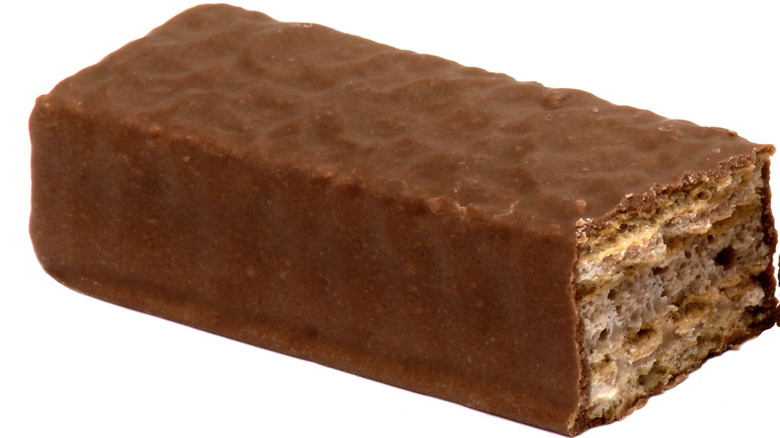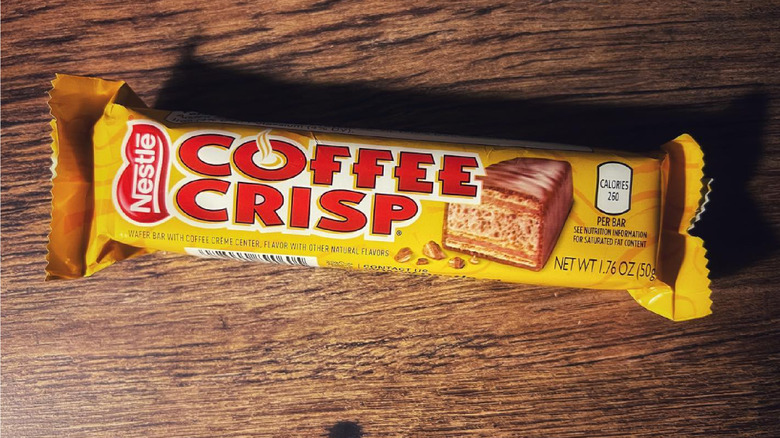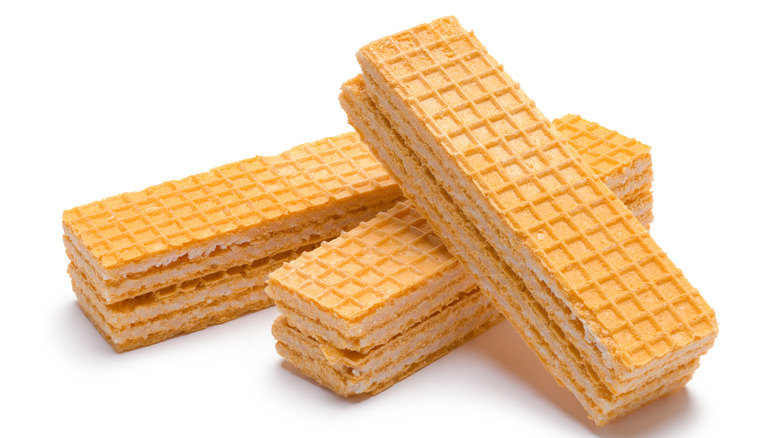Coffee Crisp Is One Of Canada's Most Beloved Chocolate Bars
Biting into a candy bar can be a transportive experience — a strong hit of nostalgia right back to childhood. For many Canadians, that cherished throwback is the Coffee Crisp. Reminiscent of a Kit Kat — in fact, they're produced by the same brand outside the United States — this tasty chocolate bar is an easy-going delight.
It consists of two vanilla wafers, sandwiching an approachable coffee-flavored cream, all covered in a delectable chocolate exterior. A few variations of the sweet exist, including in ice cream and nibble form, but the classic yellow packaging is the most iconic. A staple of Northern Halloweens and convenience store snacks.
So with over 150 million bars in annual production, why aren't Coffee Crisps more noted abroad? It's all due to the bar's regional production and distribution. To this day, all exemplars are made in a single Toronto factory. So, in turn, it's a candy interlinked only to the Great White North. Let's dive into its origins.
History of Coffee Crisps
Although so beloved in Canada, the chocolate candy bar was actually invented in the United Kingdom in the 1930s. Originally called Rowntree's Wafer Crisp, the confection went through a few iterations before hitting the Canadian market. Coffee was added as a component in 1938, and the bar started production in Toronto after a year. A decade later, Coffee Crisps had already established itself as a Canadian hit.
Originator Rowntree also created a similar sweet, more recognizable stateside — the Kit Kat. Today, both of their international productions are overseen by heavyweight Nestle. And despite consumer outcries, the Coffee Crisp never achieved accessibility in the U.S. It had a limited run from 2006 to 2009, with only a few outlets selling the delectable creation. As a result, its associations with Canada only strengthened — it's the only marketplace the bar can be conveniently purchased. Factor in a memorable Canadian marketing campaign, and it's not hard to understand the bar's iconic nature.
How are Coffee Crisps made?
The Coffee Crisp contains three prominent components — foam coffee flavoring, vanilla wafers, and a chocolate exterior. The coffee extract utilized does contain essence from a real cup of joe, so the bar does contain caffeine. However, it's a small amount, approximately ten milligrams, which is nearly one-tenth the amount in an 8-ounce coffee.
The rest of the bar comes together with components like sugar, wheat flour, palm oil, and cocoa butter, as well as cocoa masses for the chocolate exterior. While the precise industrial process is not released to the public, there are home-spun recipes to produce a similar result.
Assembly starts with long vanilla wafer cookies, which can be made from scratch but are more easily purchased. A buttercream made with espresso powder, vanilla, butter, and sugar gets sandwiched inside, and the confection is set in the fridge. Next, it's covered in melted dark chocolate and set one more time. While the result won't reproduce the impeccably uniform shape of a store-bought bar, there is an appealing quality to a cold Coffee Crisp whipped up by hand.
Where to buy Coffee Crisps
Of course, the easiest place to obtain a Coffee Crisp is in Canada. It won't take much searching — simply venture to a grocery or convenience store. If living near the border, Canadian stores will even offer an extra supply for a hit of nostalgia.
However, when it comes to procuring the bars abroad, the search becomes trickier. While Nestle allows for distribution stateside, it's not promoted, meaning stock is low. Purchasing online is the easiest method, orders can be placed via Nestle's website. Alternatively, head to a Canadian-spun grocer or a boutique candy marketplace.
Some suggest such a restricted sale is due to Crisp's similarity to other bars sold in the U.S. However, more likely, its limited range promotes regionalized reverence. If sold globally, Coffee Crisps wouldn't be a Canadian creation that are still produced only in a Toronto location. Such a national affiliation gives each Crisp bite an extra Canadian-inflected note.



